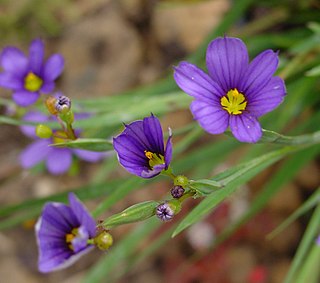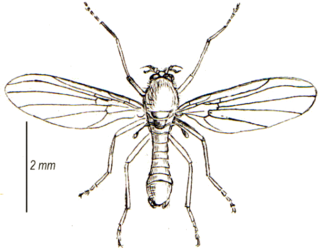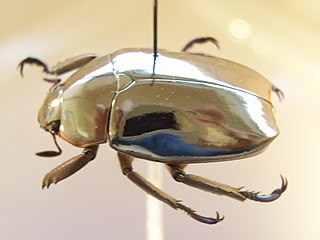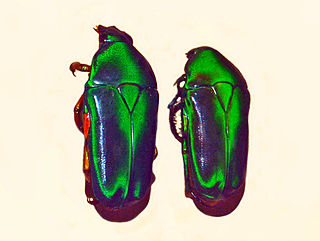
The family Scarabaeidae, as currently defined, consists of over 35,000 species of beetles worldwide; they are often called scarabs or scarab beetles. The classification of this family has undergone significant change. Several groups formerly treated as subfamilies have been elevated to family rank, and some reduced to lower ranks. The subfamilies listed in this article are in accordance with those in Catalog of Life (2023).

Antirrhinum is a genus of plants in the Plantaginaceae family, commonly known as dragon flowers or snapdragons because of the flowers' fancied resemblance to the face of a dragon that opens and closes its mouth when laterally squeezed. They are also sometimes called toadflax or dog flower. They are native to rocky areas of Europe, the United States, Canada, and North Africa. Antirrhinum species are widely used as ornamental plants in borders and as cut flowers.

Sisyrinchium is a large genus of annual to perennial flowering plants in the family Iridaceae. Native to the New World, the species are known as blue-eyed grasses. Although they are not true grasses (Poaceae), they are monocots.

Thaumaleidae, the solitary midges or trickle midges, are a group of nematoceran flies related to the Ceratopogonidae, Chironomidae, and the Simuliidae. They are small, stocky, yellow to brown flies (3–4 mm). Very few species are known for this family. Larvae are found in films on rocks and the nonfeeding adults are usually found on foliage along the same streams in which the larvae are found. A few solitary midges are found in the Southern Hemisphere, but Thaumaleidae are generally an Holarctic family.

Euphoria is a genus of scarab beetles in the subfamily Cetoniinae, the flower or fruit chafers. They are native to the Americas, where they are distributed from Canada to Argentina. They are most diverse in Mexico and Central America. As of 2012, there are 59 species in the genus.

Flower chafers are a group of scarab beetles comprising the subfamily Cetoniinae. Many species are diurnal and visit flowers for pollen and nectar, or to browse on the petals. Some species also feed on fruit. The group is also called fruit and flower chafers, flower beetles and flower scarabs. There are around 4,000 species, many of them still undescribed.

Phyllophaga is a very large genus of New World scarab beetles in the subfamily Melolonthinae. Common names for this genus and many other related genera in the subfamily Melolonthinae are May beetles, June bugs, and July beetles. They range in size from 12 to 35 mm and are blackish or reddish-brown in colour, without prominent markings, and often rather hairy ventrally. These beetles are nocturnal, and are attracted to artificial lights in great numbers.

Lewis Sperry Chafer was an American theologian. He co-founded Dallas Theological Seminary with his older brother Rollin Thomas Chafer (1868-1940), served as its first president, and was an influential proponent of Christian Dispensationalism in the early 20th century. John Hannah described Chafer as a visionary Bible teacher, a minister of the gospel, a man of prayer with strong piety. One of his students, Charles Caldwell Ryrie, who went on to become a world renowned theologian and scholar, stated that Chafer was an evangelist who was also "an eminent theologian."

Macrodactylus subspinosus is a North American beetle of the family Scarabaeidae. The members of its genus are known as "rose chafers", not to be confused with the European rose chafer, Cetonia aurata. M. subspinosus occurs from Eastern Canada to Colorado and is considered a pest of many crops and flowers. It is given its common name of rose chafer because it eats the leaves of roses, although it also feeds on many other plants.

Angophora hispida grows as a mallee, or as a tree to about 7 m (25 ft) in height. A. hispida's small size, especially when compared to its Angophora and Eucalyptus relatives, leads to it being known by the common name dwarf apple. It is native to a relatively small patch of central New South Wales – from just south of Sydney up to the Gosford area. The plant's leaves are sessile (stalk-less) and hug the stem with heart-shaped bases. Its previous name – A. cordifolia – referred to these cordate leaves. Another distinctive feature is the red bristly hairs that cover the branchlets, flower bases and new growth. This leads to the specific epithet hispida.

Eupoecila australasiae, commonly known as the fiddler beetle or rose chafer, is a colourful green- or yellow-and-black member of the scarab beetle family from eastern Australia.

Rutelinae or shining leaf chafers is a subfamily of the scarab beetles. It is a very diverse group; distributed over most of the world, it contains some 200 genera with over 4,000 described species in 7 tribes. Several taxa have yet to be described. A few recent classifications include the tribe Hopliini, but this is not generally accepted.
Plaesiorrhina is a genus of fruit and flower chafers belonging to the family Scarabaeidae, subfamily Cetoniinae, found in Africa.

Tmesorrhina is a genus of beetles belonging to the family Scarabaeidae, subfamily Cetoniinae.

Argyripa lansbergei is a species of flower chafer belonging to the family scarab beetles.

Trichiotinus is a genus of fruit and flower chafers in the family Scarabaeidae. There are about 8 described species in Trichiotinus, all native to the New World.

Gymnetini is a tribe of fruit and flower chafers in the family Scarabaeidae. According to Catalogue of Life (2023), there are 32 genera in Gymnetini, mostly New World.

Trigonopeltastes is a genus of fruit and flower chafers in the beetle family Scarabaeidae, found in North and Central America. There are more than 20 described species in Trigonopeltastes.

Gametis is a genus of flower chafer in the family Scarabaeidae, with under 10 species found in Asia.

Ixorida is a genus of flower chafers. There are about 10 species, all from tropical Asia.



















